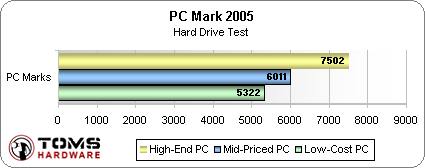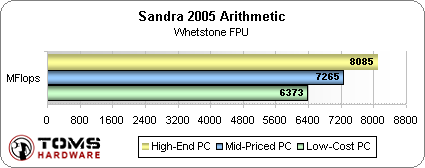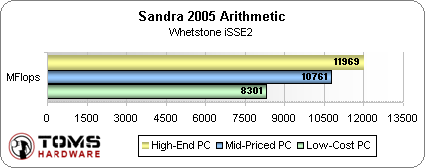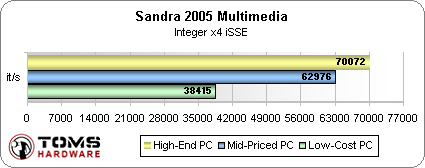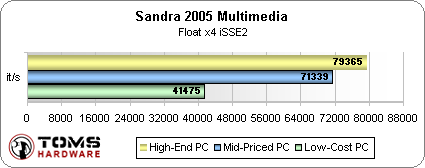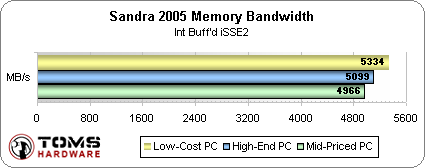System Builder Marathon: Day 4
Synthetics, Continued
Of course, if you factor in price, the low-cost PC is far and away looking like the best bang for your buck in the type of tasks that PCMark 05 is emulating. For under 20% of the price of the high-end system, the low-cost PC is achieving better than 50% of the performance. Let's see if this holds up on a component-by-component basis.
The Athlon 64 CPU architecture in the low-cost system shows it's weakness vs. the Core2 Duo architecture. Still, the low-cost CPU is holds up pretty well when it's price is factored.
The midrange e6600 is looking very nice here, competing well against the far more expensive Core2 Duo x6800 CPU.
Even though its memory is running the slowest of the bunch - and it's running in single channel mode, no less - the Athlon 64's on-die memory controller helps the 3800+ a bit in the memory test. It's still not much of a match for the Core2 duo platforms, but as usual the low-cost PC's memory stands up well when you consider cost. The mid-range e6600 is looking very strong when compared to the much more expensive Core2 Duo x6800 platform.
The high-end and midrange PCs are using identical drive hardware - the Western Digital Caviar RE2 WD5000YS - but the high-end system sets itself apart, obviously because it's the only PC in the test using a RAID 0 configuration. The low-cost PC's 160 GB Samsung SATA drive is holding up alright, but the mid-priced system's newer drive technology beats up on the older, cheaper drive in the budget build.
Sandra 2005 Arithmetic benchmarks point to proportionally higher performance gains for Intel's ALU as found in the mid-priced and high-end configurations, with AMD's FPU putting up a good show considering its low price.
Sandra 2005 Multimedia says "skip the cheap stuff", or does it? These benchmarks don't tell us much about real-world performance, but at least we can see how the technologies stand in relation to each other with Sandra's synthetic algorithms.
The Sandra Memory Bandwidth benchmark shows the low-cost system with amazingly little memory bandwidth penalty for its use of a single memory channel, compared to the mid-priced and high-end dual-channel configurations. The reason could be AMD's on-die memory controller proving itself more efficient than Intel's "front side bus" technology.
Get Tom's Hardware's best news and in-depth reviews, straight to your inbox.
Don Woligroski was a former senior hardware editor for Tom's Hardware. He has covered a wide range of PC hardware topics, including CPUs, GPUs, system building, and emerging technologies.


